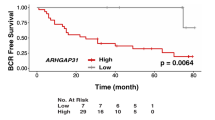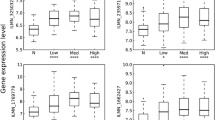Abstract
The presence of circulating tumor cells (CTC) is common in prostate cancer patients, however until recently their clinical significance was unknown. The CTC stage is essential for the formation of distant metastases, and their continuing presence after radical prostatectomy has been shown to predict recurrent or latent disease. Despite their mechanistic and prognostic importance, due both to their scarcity and difficulties in their isolation, little is known about the characteristics that enable their production and survival. The aim of this study was to investigate the molecular mechanisms underlying the survival of CTC cells. A novel CTC cell line from the bloodstream of an orthotopic mouse model of castration-resistant prostate cancer was established and compared with the primary tumor using attachment assays, detachment culture, Western blot, flow cytometry and 2D gel electrophoresis. Decreased adhesiveness and expression of adhesion molecules E-cadherin, β4-integrin and γ-catenin, together with resistance to detachment and drug-induced apoptosis and upregulation of Bcl-2 were integral to the development of CTC and their survival. Using proteomic studies, we observed that the GRP94 glycoprotein was suppressed in CTC. GRP94 was also shown to be suppressed in a tissue microarray study of 79 prostate cancer patients, indicating its possible role in prostate cancer progression. Overall, this study suggests molecular alterations accounting for the release and survival of CTC, which may be used as drug targets for either anti-metastatic therapy or the suppression of latent disease. We also indicate the novel involvement of GRP94 suppression in prostate cancer metastasis.






Similar content being viewed by others
Abbreviations
- CTC:
-
Circulating tumor cells
- HRPC:
-
Hormone Refractory Prostate Cancer
- IEF:
-
Isoelectric focusing
- ER:
-
Endoplasmic reticulum
References
Marugame T, Mizuno S (2005) Comparison of prostate cancer mortality in five countries: France, Italy, Japan, UK and USA from the WHO mortality database (1960–2000). Jpn J Clin Oncol 35:690–691
Albertsen PC, Hanley JA, Penson DF, Barrows G, Fine J (2007) 13-year outcomes following treatment for clinically localized prostate cancer in a population based cohort. J Urol 177:932–936
Mocellin S, Keilholz U, Rossi CR, Nitti D (2006) Circulating tumor cells: the ‘leukemic phase’ of solid cancers. Trends Mol Med 12:130–139
Morgan TM, Lange PH, Vessella RL (2007) Detection and characterization of circulating and disseminated prostate cancer cells. Front Biosci 12:3000–3009
Sheu CC, Yu YP, Tsai JR, Chang MY, Lin SR, Hwang JJ, Chong IW (2006) Development of a membrane array-based multimarker assay for detection of circulating cancer cells in patients with non-small cell lung cancer. Int J Cancer 119:1419–1426
Riethdorf S, Fritsche H, Muller V, Rau T, Schindlbeck C, Rack B, Janni W, Coith C, Beck K, Janicke F, Jackson S, Gornet T, Cristofanilli M, Pantel K (2007) Detection of circulating tumor cells in peripheral blood of patients with metastatic breast cancer: a validation study of the CellSearch system. Clin Cancer Res 13:920–928
Wang JY, Wu CH, Lu CY, Hsieh JS, Wu DC, Huang SY, Lin SR (2006) Molecular detection of circulating tumor cells in the peripheral blood of patients with colorectal cancer using RT-PCR: significance of the prediction of postoperative metastasis. World J Surg 30:1007–1013
Liu Z, Jiang M, Zhao J, Ju H (2007) Circulating tumor cells in perioperative esophageal cancer patients: quantitative assay system and potential clinical utility. Clin Cancer Res 13:2992–2997
Danila DC, Heller G, Gignac GA, Gonzalez-Espinoza R, Anand A, Tanaka E, Lilja H, Schwartz L, Larson S, Fleisher M, Scher HI (2007) Circulating tumor cell number and prognosis in progressive castration-resistant prostate cancer. Clin Cancer Res 13:7053–7058
Garcia JA, Rosenberg JE, Weinberg V, Scott J, Frohlich M, Park JW, Small EJ (2007) Evaluation and significance of circulating epithelial cells in patients with hormone-refractory prostate cancer. BJU Int 99:519–524
Berg A, Berner A, Lilleby W, Bruland OS, Fossa SD, Nesland JM, Kvalheim G (2007) Impact of disseminated tumor cells in bone marrow at diagnosis in patients with nonmetastatic prostate cancer treated by definitive radiotherapy. Int J Cancer 120:1603–1609
Moreno JG, Miller MC, Gross S, Allard WJ, Gomella LG, Terstappen LW (2005) Circulating tumor cells predict survival in patients with metastatic prostate cancer. Urology 65:713–718
Schamhart DH, Maiazza R, Kurth KH (2005) Identification of circulating prostate cancer cells: a challenge to the clinical implementation of molecular biology (review). Int J Oncol 26:565–577
Howard EW, Ling MT, Chua CW, Cheung HW, Wang X, Wong YC (2007) Garlic-derived S-allylmercaptocysteine is a novel in vivo antimetastatic agent for androgen-independent prostate cancer. Clin Cancer Res 13:1847–1856
Posadas EM, Gulley J, Arlen PM, Trout A, Parnes HL, Wright J, Lee MJ, Chung EJ, Trepel JB, Sparreboom A, Chen C, Jones E, Steinberg SM, Daniels A, Figg WD, Dahut WL (2005) A phase II study of perifosine in androgen independent prostate cancer. Cancer Biol Ther 4:1133–1137
Iinuma H, Okinaga K, Egami H, Mimori K, Hayashi N, Nishida K, Adachi M, Mori M, Sasako M (2006) Usefulness and clinical significance of quantitative real-time RT-PCR to detect isolated tumor cells in the peripheral blood and tumor drainage blood of patients with colorectal cancer. Int J Oncol 28:297–306
Moreno JG, O’Hara SM, Gross S, Doyle G, Fritsche H, Gomella LG, Terstappen LW (2001) Changes in circulating carcinoma cells in patients with metastatic prostate cancer correlate with disease status. Urology 58:386–392
Condeelis JS, Wyckoff J, Segall JE (2000) Imaging of cancer invasion and metastasis using green fluorescent protein. Eur J Cancer 36:1671–1680
Ma S, Guan XY, Beh PS, Wong KY, Chan YP, Yuen HF, Vielkind J, Chan KW (2007) The significance of LMO2 expression in the progression of prostate cancer. J Pathol 211:278–285
Yuen HF, Chua CW, Chan YP, Wong YC, Wang X, Chan KW (2006) Id proteins expression in prostate cancer: high-level expression of Id-4 in primary prostate cancer is associated with development of metastases. Mod Pathol 19:931–941
Foty RA, Steinberg MS (2004) Cadherin-mediated cell-cell adhesion and tissue segregation in relation to malignancy. Int J Dev Biol 48:397–409
Slack-Davis JK, Parsons JT (2004) Emerging views of integrin signaling: implications for prostate cancer. J Cell Biochem 91:41–46
Cress AE, Rabinovitz I, Zhu W, Nagle RB (1995) The alpha 6 beta 1 and alpha 6 beta 4 integrins in human prostate cancer progression. Cancer Metastasis Rev 14:219–228
Umbas R, Isaacs WB, Bringuier PP, Schaafsma HE, Karthaus HF, Oosterhof GO, Debruyne FM, Schalken JA (1994) Decreased E-cadherin expression is associated with poor prognosis in patients with prostate cancer. Cancer Res 54:3929–3933
Tran NL, Nagle RB, Cress AE, Heimark RL (1999) N-Cadherin expression in human prostate carcinoma cell lines. An epithelial-mesenchymal transformation mediating adhesion with stromal cells. Am J Pathol 155:787–798
Berezovskaya O, Schimmer AD, Glinskii AB, Pinilla C, Hoffman RM, Reed JC, Glinsky GV (2005) Increased expression of apoptosis inhibitor protein XIAP contributes to anoikis resistance of circulating human prostate cancer metastasis precursor cells. Cancer Res 65:2378–2386
Fu Y, Lee AS (2006) Glucose regulated proteins in cancer progression, drug resistance and immunotherapy. Cancer Biol Ther 5:741–744
Chen X, Ding Y, Liu CG, Mikhail S, Yang CS (2002) Overexpression of glucose-regulated protein 94 (Grp94) in esophageal adenocarcinomas of a rat surgical model and humans. Carcinogenesis 23:123–130
Wang XP, Qiu FR, Liu GZ, Chen RF (2005) Correlation between clinicopathology and expression of heat shock protein 70 and glucose-regulated protein 94 in human colonic adenocarcinoma. World J Gastroenterol 11:1056–1059
Luo J, Lubaroff DM, Hendrix MJ (1999) Suppression of prostate cancer invasive potential and matrix metalloproteinase activity by E-cadherin transfection. Cancer Res 59:3552–3556
Morita N, Uemura H, Tsumatani K, Cho M, Hirao Y, Okajima E, Konishi N, Hiasa Y (1999) E-cadherin and alpha-, beta- and gamma-catenin expression in prostate cancers: correlation with tumour invasion. Br J Cancer 79:1879–1883
Mehes G, Witt A, Kubista E, Ambros PF (2001) Circulating breast cancer cells are frequently apoptotic. Am J Pathol 159:17–20
Fernandez Y, Gu B, Martinez A, Torregrosa A, Sierra A (2002) Inhibition of apoptosis in human breast cancer cells: role in tumor progression to the metastatic state. Int J Cancer 101:317–326
Zellweger T, Ninck C, Bloch M, Mirlacher M, Koivisto PA, Helin HJ, Mihatsch MJ, Gasser TC, Bubendorf L (2005) Expression patterns of potential therapeutic targets in prostate cancer. Int J Cancer 113:619–628
Tran NL, Adams DG, Vaillancourt RR, Heimark RL (2002) Signal transduction from N-cadherin increases Bcl-2. Regulation of the phosphatidylinositol 3-kinase/Akt pathway by homophilic adhesion and actin cytoskeletal organization. J Biol Chem 277:32905–32914
Coll ML, Rosen K, Ladeda V, Filmus J (2002) Increased Bcl-xL expression mediates v-Src-induced resistance to anoikis in intestinal epithelial cells. Oncogene 21:2908–2913
Liu AX, Jin F, Zhang WW, Zhou TH, Zhou CY, Yao WM, Qian YL, Huang HF (2006) Proteomic analysis on the alteration of protein expression in the placental villous tissue of early pregnancy loss. Biol Reprod 75:414–420
Vawter MP, Crook JM, Hyde TM, Kleinman JE, Weinberger DR, Becker KG, Freed WJ (2002) Microarray analysis of gene expression in the prefrontal cortex in schizophrenia: a preliminary study. Schizophr Res 58:11–20
Cheng Q, Lau WM, Tay SK, Chew SH, Ho TH, Hui KM (2002) Identification and characterization of genes involved in the carcinogenesis of human squamous cell cervical carcinoma. Int J Cancer 98:419–426
Kubota H, Suzuki T, Lu J, Takahashi S, Sugita K, Sekiya S, Suzuki N (2005) Increased expression of GRP94 protein is associated with decreased sensitivity to X-rays in cervical cancer cell lines. Int J Radiat Biol 81:701–709
Lee AS (2001) The glucose-regulated proteins: stress induction and clinical applications. Trends Biochem Sci 26:504–510
Reddy RK, Dubeau L, Kleiner H, Parr T, Nichols P, Ko B, Dong D, Ko H, Mao C, DiGiovanni J, Lee AS (2002) Cancer-inducible transgene expression by the Grp94 promoter: spontaneous activation in tumors of various origins and cancer-associated macrophages. Cancer Res 62:7207–7212
Korbelik M, Sun J, Cecic I (2005) Photodynamic therapy-induced cell surface expression and release of heat shock proteins: relevance for tumor response. Cancer Res 65:1018–1026
Takagi S, Miyagawa S, Ichikawa E, Soeda J, Miwa S, Miyagawa Y, Iijima S, Noike T, Kobayashi A, Kawasaki S (2004) Dendritic cells, T-cell infiltration, and Grp94 expression in cholangiocellular carcinoma. Hum Pathol 35:881–886
Baker-LePain JC, Sarzotti M, Fields TA, Li CY, Nicchitta CV (2002) GRP94 (gp96) and GRP94 N-terminal geldanamycin binding domain elicit tissue nonrestricted tumor suppression. J Exp Med 196:1447–1459
Gastpar R, Gehrmann M, Bausero MA, Asea A, Gross C, Schroeder JA, Multhoff G (2005) Heat shock protein 70 surface-positive tumor exosomes stimulate migratory and cytolytic activity of natural killer cells. Cancer Res 65:5238–5247
Yang Q, Goding SR, Hokland ME, Basse PH (2006) Antitumor activity of NK cells. Immunol Res 36:13–25
Bastide C, Bagnis C, Mannoni P, Hassoun J, Bladou F (2002) A Nod Scid mouse model to study human prostate cancer. Prostate Cancer Prostatic Dis 5:311–315
Wang Q, He Z, Zhang J, Wang Y, Wang T, Tong S, Wang L, Wang S, Chen Y (2005) Overexpression of endoplasmic reticulum molecular chaperone GRP94 and GRP78 in human lung cancer tissues and its significance. Cancer Detect Prev 29:544–551
Wang XP, Liu GZ, Song AL, Chen RF, Li HY, Liu Y (2005) Expression and significance of heat shock protein 70 and glucose-regulated protein 94 in human esophageal carcinoma. World J Gastroenterol 11:429–432
Wang XP, Liao J, Liu GZ, Wang XC, Shang HW (2005) Co-expression of heat shock protein 70 and glucose-regulated protein 94 in human gastric carcinoma cell line BGC-823. World J Gastroenterol 11:3601–3604
Acknowledgment
The work was supported by American Association for Cancer Research to X. Wang.
Author information
Authors and Affiliations
Corresponding authors
Rights and permissions
About this article
Cite this article
Howard, E.W., Leung, S.C.L., Yuen, H.F. et al. Decreased adhesiveness, resistance to anoikis and suppression of GRP94 are integral to the survival of circulating tumor cells in prostate cancer. Clin Exp Metastasis 25, 497–508 (2008). https://doi.org/10.1007/s10585-008-9157-3
Received:
Accepted:
Published:
Issue Date:
DOI: https://doi.org/10.1007/s10585-008-9157-3




